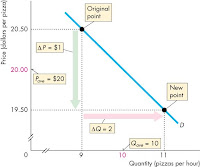The price elasticity of demand measures how much the quantity demanded of a good changes when its price changes. The prices definition of price elasticity is the percentage change in quantity demanded divided by the percentage change in price.
Goods vary enormously in their price elasticity or sensitivity to price change. When the price elasticity of a good is high, we say that the good has ‘elastic’ demand, which means that its quantity demanded responds greatly to price change. When the price elasticity of a good is low, it is ‘inelastic’ and its quantity demanded responded little to price change.
For necessities like food, fuel, shoes and prescription drugs demand tends to be inelastic. Such items are the staff of life and cannot easily be forgone when their price rise. By contrast, you can easily substitute other goods when luxuries.
Economic factors determine the size of price elasticity’s for individual goods. Elasticity tends to be higher when the goods are luxuries. When substitutes are available and when consumers have more time to adjust their behavior.

No comments:
Post a Comment